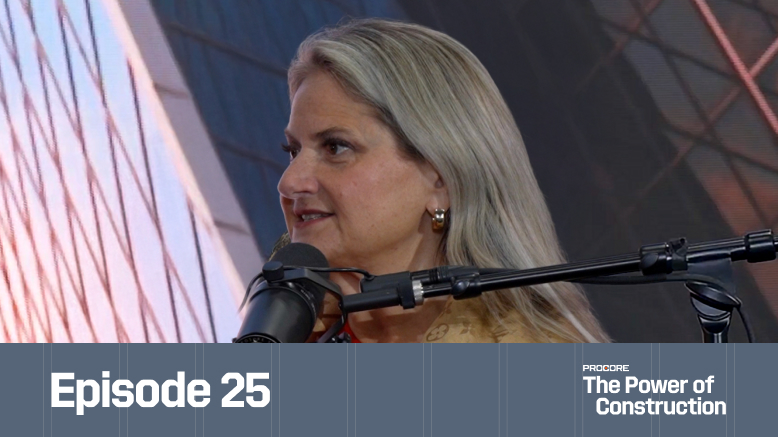— 10 min read
Indirect Costs in Construction: An Essential Guide


Last Updated Jul 22, 2025

Jimmy Primsky
Enterprise Account Executive
Jimmy Primsky is an Enterprise Account Executive at Procore. Previously, he led technology strategy and operations at WeWork as a Senior Manager of Global Commercial Management. He is a Certified Public Accountant, and earned a BBA and MA in Accounting from the University of Colorado. He lives in Denver.

Taylor Riso
Contributing Writer
91 articles
Taylor Riso is a marketing professional with more than 10 years of experience in the construction industry. Skilled in content development and marketing strategies, she leverages her diverse experience to help professionals in the built environment. She currently resides in Portland, Oregon.
Last Updated Jul 22, 2025

Indirect costs in construction refer to expenses that, while not directly tied to a specific building or structure, are essential for the overall execution of a project. While these are often overlooked, they are necessary to complete the job. Understanding indirect costs is key for accurate project budgeting, strategic bidding, and maintaining project profitability.
In this article, we'll navigate the landscape of indirect costs in the construction industry, highlighting the different types and their importance for success and profitability.
Table of contents
Direct vs. Indirect Costs
To understand indirect costs, it's helpful to first understand direct costs. Direct construction costs are directly tied to a specific project, such as materials and onsite labor. In contrast, indirect costs are those that support the project but aren't linked to any specific construction activity.
To make the difference between the two clear, here is a chart to help compare and contrast direct and indirect costs:
| Attribute | Direct Costs | Indirect Costs |
|---|---|---|
| Definition | Expenses directly associated with specific construction activities or tasks | Costs that support the overall project but aren't tied to any specific construction activity |
| Examples | Building materials (e.g. cement, steel, nails), on-site labor (e.g. carpenters), subcontractor fees | Vehicles (including fuel and maintenance), administrative costs, office rent and supplies |
| Allocation | Easily traceable to individual tasks or activities within the project | Spread across the project (or multiple projects), often allocated based on certain cost drivers or estimates |
| Role in the Project | Primary expenditures (i.e. materials, labor, and activities needed for construction) that constitute the bulk of the construction budget | Supportive role, ensuring smooth operations and providing essential auxiliary services |
| Impact on Profitability | Direct influence on material and labor costs, with variances significantly affecting project costs and profitability | Influence overhead and general expenses. Misestimations can impact firm profit margins |
Understanding the distinct roles and impacts of both direct and indirect costs is vital for accurate budgeting, efficient project management, and ensuring the financial viability of construction projects.
Types of Indirect Costs
Knowing the types of indirect costs is key to organizing and accounting for them. Here are a few of the most common indirect costs found in the construction business:
Overhead Costs
These are costs not tied to a specific job but are essential for business operations. Examples include rent for office space, utilities, office supplies or storage for equipment.
General and Administrative (G&A) costs
These costs encompass the day-to-day operations of running a construction business. They include salaries of non-project staff, including operations and marketing personnel, accounting services, and other administrative expenses. While G&A costs for a firm usually remain relatively steady, they can fluctuate depending on the size and organizational structure of the company.
Tools and Equipment
The tools used in construction projects — especially those that are reusable across different projects —are considered indirect costs. While a specific excavator might be a direct cost to a particular project, smaller tools used across multiple projects, like hammers or drills, are considered indirect costs. Similarly, vehicles that are used across different jobsites, along with their maintenance and fuel, also contribute to indirect expenses.
Project-specific Indirect Costs
Also referred to as general conditions, these are expenses that, while not directly tied to specific construction tasks, are incurred due to the unique conditions or requirements of a particular project. Unlike general overhead expenses, these costs are specific to an individual project and may vary from project to project. Some examples include:
- Salaries, wages, and benefits for on-site personnel including project manager, safety manager, superintendents, etc.
- Trailers or temporary jobsite office space
- Temporary utilities required for the project
- Site maintenance costs including waste disposal, daily cleanup etc.
Labor Related
In addition to wages for management personnel, this encompasses costs associated with providing health insurance, retirement contributions, workers' compensation, and other benefits for these staff.
Insurance and Bonding
Costs that provide financial safeguards against potential project challenges and unexpected events. Insurance can encompass general liability, builder’s risk, professional liability, worker’s compensation, and excess liability. Common types of bonds include bid, performance, payment and maintenance bonds.
Site-specific
Costs that arise due to unique project conditions or requirements and can include everything from site security to specialized utility setups.
Regulatory Compliance
Expenses that are incurred to ensure that all construction activities adhere to local, state, and federal regulations, including permit fees, inspection costs, and expenses related to environmental, health or safety standards.
Stay updated on what’s happening in construction.
Subscribe to Blueprint, Procore’s free construction newsletter, to get content from industry experts delivered straight to your inbox.

Indirect Costs vs. Soft Costs
In construction, both indirect and soft costs denote expenses that aren't directly tied to the physical construction activities. However, they do differ in subtle ways.
Soft Costs
Soft costs are expenses that are not directly tied to the labor, materials, and equipment that go into building the structure. They are typically intangible and administrative in nature, often incurred before the construction begins or after it concludes. For example, common soft costs on a project include architectural and design fees, permitting fees, and land acquisition costs.
Indirect Costs
Indirect costs, on the other hand, are more closely tied to on-site construction activities but not to the actual materials or labor. These often relate more to supporting the construction process onsite. Some common examples include temporary site facilities and utilities as well as tools and equipment rentals.
Furthermore, soft costs often involve third parties like architects, financiers, and legal consultants, whereas indirect costs are more intrinsic to the contractor's day-to-day site functions.
In essence, while there is overlap between soft costs and indirect costs, understanding the difference is crucial for budgeting, planning, and managing a construction project. Proper accounting and allocation of both types of costs ensure the project's financial viability and success.
The 5 Steps for Calculating and Managing Indirect Costs
Calculating and managing indirect costs in construction is essential for ensuring accurate project budgeting, cost control and ultimately profitability. The process involves identifying all the indirect costs and then allocating them appropriately. Here’s an overview of the steps involved:
1. Identify all indirect costs.
The first step is to identify all potential indirect costs, whether they're associated with individual construction projects or broader overheads necessary for the operation of the firm. This could encompass everything from site facilities and equipment rentals to office utilities and administrative salaries.
2. Estimate the indirect cost budget.
After pinpointing all indirect expenses, the next step is to project their anticipated amounts. Fixed indirect costs, such as monthly office rent or the one-off cost of establishing a project site office, remain relatively constant. On the other hand, variable indirect costs shift depending on the project's magnitude and operational needs—examples include equipment fuel costs that vary with usage and market fluctuations or marketing expenses tied to business development. Differentiating between these cost types is essential for thorough and precise budget forecasting.
3. Determine an allocation method.
When allocating indirect costs, consistency in the chosen method is key, more so than the specific method itself. The purpose of allocation is to determine a fair and logical way to distribute indirect costs so that individual projects, tasks, or departments bear an appropriate share of these expenses. Through allocation, stakeholders are able to determine the true cost of individual tasks or projects. Let’s examine some common allocation methods.
Absorption
Absorption is the method in which all project costs, both direct (like materials and labor) and indirect (like office rent or project management fees), are allocated to specific construction tasks or phases. Each task or phase of the work "absorbs" a proportionate share of the total costs.
Allocation Base
The allocation base is the chosen measure or standard used to distribute indirect costs among various projects, tasks, or phases within those projects. It serves as a “yardstick” to allocate indirect costs.
Some common allocation bases include:
- Direct labor hours
- Machine hours
- Material costs
- Square footage
- Contract value
Activity-based Costing
Activity-based costing (ABC) allocates costs based on the actual activities that drive them. This provides a more granular view of costs and can lead to more accurate project cost estimates and profitability analyses.
4. Include contingency.
Factor in a financial cushion to accommodate unforeseen expenses or uncertainties. This is essential to ensure projects or business operations can continue smoothly even if unexpected costs arise. Despite meticulous planning, the construction landscape is rife with uncertainties, making the emergence of unplanned costs almost inevitable. By setting aside contingency, firms can safeguard their profitability and maintain uninterrupted operations, ensuring they're ready to navigate any financial surprises.
5. Review periodically.
In the dynamic world of construction, a static approach to costs can lead to financial missteps. Specifically, when dealing with indirect costs, periodic assessments are essential to monitoring financial performance. Some types of indirect costs such as insurance, licensing, or materials can vary significantly with market conditions. Regularly revisiting these ensures that a construction firm isn't caught off guard by unexpected surges or drops in expenses.
By consistently reviewing indirect costs, firms can discern recurring trends or irregularities. Take, for instance, the cost of responding to requests for proposal (RFPs) consistently runs over budget, or if there are potential savings from bulk purchasing of materials. These reviews become opportunities for operational optimization and to enhance cost-efficiency. Moreover, they offer a chance to compare budgeted vs actual indirect costs, allowing for necessary adjustments to be made to safeguard profit margins.
Indirect costs, although often overshadowed by their direct counterparts, hold significant sway over a project's bottom line. Ensuring their meticulous assessment and proactive oversight not only safeguards profitability but also establishes the foundation for successful project execution.
Technology in Managing Indirect Costs
In the construction industry, the effective management of indirect costs can be a complex task, but technology offers a variety of solutions to streamline this process. The integration of sophisticated software tools and data analytics has revolutionized how these costs are handled, leading to increased accuracy and efficiency.
Project Management Software
Modern project management tools can go beyond tracking project timelines and resource allocations. They can integrate various aspects of construction project management, including budgeting and financial oversight. These tools offer construction-specific features, and can help capture and categorize indirect costs like administrative expenses, equipment maintenance and supervision charges.
By offering real-time tracking of expenses and linking them to specific project milestones, some of these tools can provide a panoramic view of where indirect costs are being incurred and how they align with the project timeline. This integration centralizes data and can aid in making informed decisions, and that indirect costs may remain within the allocated budget.
Estimating and Accounting Software
Accurate estimating lays the foundation for success in construction. Today's cost estimation software solutions help streamline the process of calculating indirect costs, integrating market trends, historical data, and predictive algorithms. Once the project is underway, accounting modules within these tools help track actual expenses against the budgeted figures, and highlight any deviations.
Data Analytics and Predictive Tools
In an industry where past trends can inform future decisions, data analytics and predictive tools can play a large role. By analyzing historical data, these tools can identify patterns in indirect cost overruns or savings, providing valuable insights for future projects. Predictive analytics can help forecast potential cost deviations, allowing project managers to proactively adjust budgets or strategies to mitigate risks.
Incorporating technology in the management of indirect costs not only brings precision but can also add a layer of predictability in the uncertainty of the construction industry. By harnessing digital tools, construction firms can assist in bringing accuracy, foresight, and agility to their financial management.
Was this article helpful?
Thank you for your submission.
91%
9%
You voted that this article was . Was this a mistake? If so, change your vote
Scroll less, learn more about construction.
Subscribe to The Blueprint, Procore’s construction newsletter, to get content from industry experts delivered straight to your inbox.
By clicking this button, you agree to our Privacy Notice and Terms of Service.
Thank you!
You’re signed up to receive The Blueprint newsletter from Procore. You can unsubscribe at any time.
Categories:
Written by

Jimmy Primsky
Enterprise Account Executive | Procore
Jimmy Primsky is an Enterprise Account Executive at Procore. Previously, he led technology strategy and operations at WeWork as a Senior Manager of Global Commercial Management. He is a Certified Public Accountant, and earned a BBA and MA in Accounting from the University of Colorado. He lives in Denver.
View profile
Taylor Riso
Contributing Writer
91 articles
Taylor Riso is a marketing professional with more than 10 years of experience in the construction industry. Skilled in content development and marketing strategies, she leverages her diverse experience to help professionals in the built environment. She currently resides in Portland, Oregon.
View profileExplore more helpful resources

Defending Against Financial & Legal Risks on Megaprojects
The construction industry has seen marked growth in megaprojects. Some experts classify any project over $500 million as a megaproject, while others argue that the build needs to be $1...

Unlocking Project Intelligence: Moving from Raw Data to Actionable Insights
The construction industry faces a wide range of challenges, from ongoing labor shortages to frequent cost overruns. But some the biggest hurdles all stem from unpredictability. The general contractors (GCs)...

Who is accountable for innovation in construction?
Everyone says construction needs to innovate—but no one agrees on who’s actually responsible for making it happen. Is it the owner? The builders? The tech vendor? Or is innovation everyone’s...

Integrated Project Delivery in Practice: A Framework for Collaboration
On construction projects, traditional delivery methods put different stakeholders in their own silos. While the design team feeds drawings and specifications to the general contractor (GC), the GC’s expertise in...
Free Tools
Calculators
Use our calculators to estimate the cost of construction materials for your next project.
Templates
Find a template to help you with your construction project tasks.
Material Price Tracker
Get the latest U.S. retail prices and view historical trends for common building materials.
Glossary
Explore key terms and phrases used in the industry.
